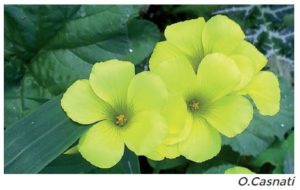 Common name: Yellow sorrel
Common name: Yellow sorrel
Scientific name: Oxalis pes-caprae
Brief description: A small perennial plant that forms large carpets of clones that originate from annual bulbs. The common name “yellow clover” is given by the shape of the leaves, similar to that of the clover, and by the flashy yellow flower that appears between January and March. The flowers are formed by 5 petals joined to form a broad cup, lemon-yellow in colour. In late spring the plants dry up, however the underground bulbs remain alive, which will then give life to a new colony the following year.
Biology and ecology: Reproduction through seeds is a very complicated process that requires cross-pollination between three forms of the same species, of which only one is very common in Europe; for this reason reproduction in our country occurs only via vegetative means. Bulbs can be dispersed mechanically when the soil is moved by animals digging for roots, tubers or insects, by people working the land or washouts of the soil after heavy rain.
Distribution in the Tuscan Archipelago and introduction: Oxalis pes-caprae is a species originating from South Africa, introduced in the early 800s in various parts of the Mediterranean. In the Tuscan Archipelago it is present in all of the 7 main islands.
Impact: It is one of the most harmful alien species for agriculture in Mediterranean environments (but also in many other parts of the world), as it invades olive groves, orchards and vegetable gardens.
Management in protected area: with the “Resto con Life” project, eradication of this species is planned for the Island of Montecristo, where some nuclei are confined near Cala Maestra.




